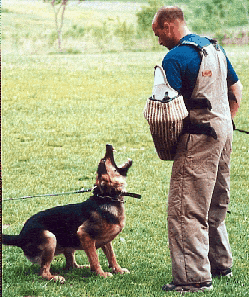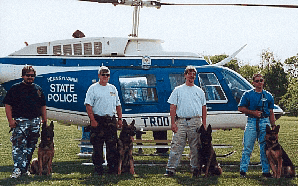

The Hegins Valley Police and Schutzhund Club, in conjunction with the Susquehanna and Swatara Township Police Departments, hosted a Police K9 Seminar. Master Trainer/Police Sergeant Richard Pastucka (also our Training Director) was the instructor. The Seminar was held at the Swatara Township Emergency Management Building on May 10, 11, and 12, 2000. There were a total of 17 participants; ten handler and dog teams. Teams came from New Jersey, Maryland, Virginia, North Carolina, and Georgia, as well as Pennsylvania.
Some of the teams were presently working in the area of patrol, which was the main focus of the seminar. Some participants were interested in becoming K9 handlers, and others were trainers who work with Police K9 teams. It's fair to say that the highlight of the seminar was the helicopter insertions, which were done with the assistance of the PA State Police Troop H Aviation Unit. Handlers and their dogs were picked up in a field, flown to the top of a mountain, where a "suspect" was waiting. As the teams alighted from the helicopter, the suspect fled, and the dog had to pursue and apprehend the suspect. After the apprehension, the team was flown back to the start.

The first day of the seminar was primarily classroom. Master Trainer Pastucka focused on theories of scent, obedience, and agitation. The day ended with assessments of the dogs in agitation and obedience. This was done to determine at what level each dog was working so they could be worked without having a detrimental affect on their current training programs. Unfortunately, the evaluations had to be cut short due to thunderstorms, but they were completed on Day 2.

Day 2 was a rather long day, but no one seemed to mind. It started with classroom discussion on selecting dogs and handlers for police work. then Edward Martin, MS, DVM, provided instruction on health care for police dogs. He began with discussion about general health assessments and maintenance and ended with emergency first-aid for stret injuries including giving CPR and administering first aid for gun shot and stab wounds, and impaled objects. Dr. Martin also talked about some of the newproducts available for treating and preventing internal and external parasites.

After a quick lunch break, the participants were off to meet the chopper, after which the assessments were completed. Each of the dogs got to work on some problems including making the dogs stronger in the hold and bark, and cleaning up the outs. A cameraman from a local TV station (Channel 15) was present and filmed each of the dogs working. He was so impressed that he stayed past his quitting time. He even saw his first Belgian Malinois (which by the way, out-numbered the German Shepherds).

Then there was a dinner break, followed by building searches, vehicle exits, and handler protection scenarios. the teams all headed back to their hotels around 11:00 p.m.
The third and final day again began with some classroom. Master Trainer Pastucka discussed the importance of good decoy work. he talked about the use of muzzles in training and how to start dogs on a hidden sleeve. After a problem-solving discussion, it was back out to the field to work on some of those problems. At the end of the day, each participant was presented with a certificate of attendance designed by Club President Tim Karchnak.

All of the participants gave rave reviews of the seminar and what they had learned. Not only did each participant find hidden potential in his dog, but he also learned techniques for cultivating that potential. Master Trainer Pastucka has a gift for bringing out a dog's true potential. he calls it "knowing which buttons to push." He is also very skilled at reading a dog and being able to modify behavior.

Even the participants who did not have dogs to work came away with new information and a desire to get their own dogs out and work them. One participant was determined to attend despite an on the job injury he sustained only a few days before the seminar which put him off work and unable to bring his dog.
For more information about the seminar, read our article in an upcoming issue of "Performance Canine" magazine or the Hegins Valley Police and SchH Club club report in a future issue of "USA" Magazine.